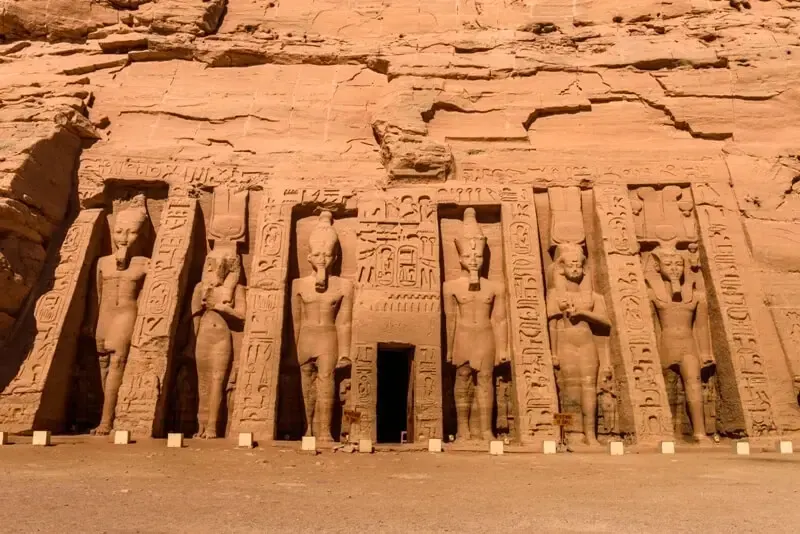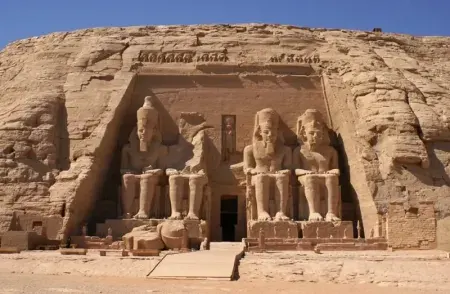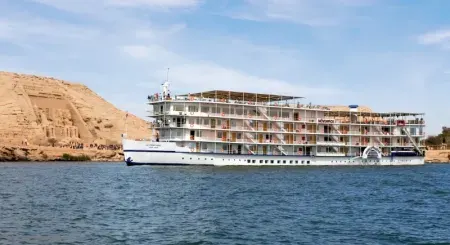Imagine standing before two colossal temples carved into a sandstone cliff, their towering statues watching over the golden desert of southern Egypt. This is Abu Simbel Temple—a masterpiece of ancient architecture and a monument to both divine ambition and modern engineering brilliance.
Built more than 3,200 years ago by Pharaoh Ramses II, the temples of Abu Simbel are not just historical landmarks—they’re an enduring testament to power, devotion, and the lengths humanity will go to preserve its heritage.
In this guide, we’ll take you on a deep dive into the awe-inspiring Temple of Ramses II and its companion, the Temple of Nefertari, uncovering the history, myths, astronomical wonders, and the daring UNESCO-led relocation that saved them from a watery grave.

Why Was Abu Simbel Built?
Commissioned by Ramses II during Egypt’s 19th Dynasty, Abu Simbel Temple was designed to impress—both the gods and Egypt’s enemies. Located near the modern-day border with Sudan, it was a grand statement of Egypt’s southern power and Ramses’ deified status.
The Temple of Ramses II
The Great Temple, dedicated to gods Amun-Ra, Ra-Horakhty, and Ptah (alongside Ramses himself), features four 20-meter (66-foot) seated statues of the king guarding its entrance. Inside, intricate carvings depict Ramses’ military triumphs—most famously, the Battle of Kadesh.
The Temple of Nefertari
Next to it stands the Small Temple, built for Ramses’ beloved queen, Nefertari. Rarely in ancient Egypt was a queen honored with such architectural grandeur. Six standing statues grace its facade—four of Ramses and two of Nefertari—equal in size, symbolizing her elevated status.
The Solar Miracle: A Celestial Wonder at Abu Simbel
Twice a year, the sun performs a sacred dance with the Temple of Ramses II. On February 22 and October 22, the morning light aligns perfectly with the temple’s inner sanctuary, illuminating three of four statues—those of Amun-Ra, Ra-Horakhty, and Ramses. Ptah, god of the underworld, fittingly remains in darkness.
These solar alignment dates are believed to mark Ramses II’s birthday and coronation, reinforcing his divine connection.
Saving Abu Simbel: The Greatest Archaeological Rescue
When Egypt planned the Aswan High Dam in the 1960s, rising waters of Lake Nasser threatened to submerge the Abu Simbel Temples forever. A global rescue effort, led by UNESCO, launched one of history’s most ambitious engineering feats.
How the Temples Were Moved
- Over 1,040 blocks, each weighing up to 30 tons, were carefully cut from the mountain.
- The entire complex was relocated 65 meters higher and 200 meters back to a man-made cliff.
- The operation took four years (1964–1968) and cost over $40 million (equivalent to hundreds of millions today).
This unprecedented endeavor preserved one of the world’s most cherished monuments for future generations.
Why You Must Visit Abu Simbel
Abu Simbel isn’t just a historical site—it’s a soul-stirring experience. Here's why every traveler should make the journey:
Marvel at Monumental Artistry
The scale and precision of the Abu Simbel Temple are extraordinary. From 20-meter statues to the detailed interior reliefs, every inch reflects ancient craftsmanship at its finest.
Witness the Sunrise Spectacle
Experience the legendary sun alignment during the Abu Simbel Sun Festival. Join crowds before dawn to watch the sunlight flood the inner sanctum—it’s a moment you’ll never forget.
Enjoy a Serene Experience
Unlike the bustling Pyramids of Giza, Abu Simbel’s remote location means fewer crowds and a more intimate connection with ancient Egypt.
Be Inspired by Human Resilience
The relocation of Abu Simbel Temples is a reminder that when culture is at stake, global collaboration can achieve miracles.
How to Visit Abu Simbel
From Aswan
Most visitors join early morning convoys or take a short domestic flight. The drive takes about 3.5 to 4 hours, with departures typically before sunrise.
By Lake Nasser Cruise
For a luxurious and scenic approach, consider a Lake Nasser cruise. These multi-day trips end or begin at Abu Simbel and offer a unique view of Nubian treasures.
When to Visit Abu Simbel
October to February: Cooler weather and clear skies.
February 22 & October 22: Best to witness the solar alignment (expect crowds and early starts!).
Top Tips for Visiting the Abu Simbel Temple
Arrive Early: Beat the heat and large tour groups.
Hire a Guide: You’ll gain deeper insights into the temple’s symbolism and history.
Wear Comfortable Shoes: There’s some walking across sand and stone paths.
Bring Water and Sunscreen: Desert sun can be intense even in winter.
Final Thoughts: Abu Simbel—A Timeless Wonder
Abu Simbel is more than just a temple—it’s a story of divine ambition, eternal love, celestial alignment, and human perseverance. The Temple of Ramses II stands not only as a monument to ancient greatness but also as a symbol of what humanity can achieve to protect its cultural legacy.
Whether you're a history lover, a spiritual seeker, or simply a curious traveler, visiting Abu Simbel Temple is an unforgettable journey into Egypt’s ancient soul.
Ready to walk in the footsteps of Ramses II? Plan your adventure to Abu Simbel today.



.webp)



